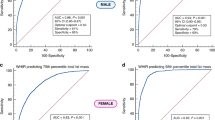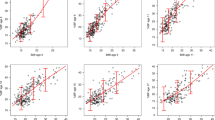Abstract
Objective:
To investigate the quantitative relationship between waist circumference (WC) and height (Ht), and subsequently the association between waist circumference index (WCI), body mass index (BMI) and body composition in pre-pubertal children.
Design:
Cross-sectional sample (n=227; boys=127) of pre-pubertal black children (age range 8.8–11.0 years) from the Bone Health sub-study of the Bt20 birth cohort study set in Soweto-Johannesburg, South Africa. Measures of height, weight and WC by anthropometry, total and truncal fat and lean mass by dual-energy X-ray absorptiometry were used in the analysis. Pearson's correlation coefficients were used to examine the associations between BMI, WC and body composition outcomes.
Results:
WC was independent of height when height was raised to a power of ∼0.8. BMI and WCI (WC/Ht) were significantly associated with total and truncal fat and lean mass in both sexes (all P<0.001). BMI showed consistently and significantly higher correlations with body composition than WCI and this association was significantly greater for fat mass than lean mass.
Conclusion:
BMI, rather than WCI, would be a better screening tool for total and truncal fat mass in both sexes before puberty.
This is a preview of subscription content, access via your institution
Access options
Subscribe to this journal
Receive 12 print issues and online access
$259.00 per year
only $21.58 per issue
Buy this article
- Purchase on Springer Link
- Instant access to full article PDF
Prices may be subject to local taxes which are calculated during checkout
Similar content being viewed by others
References
Ackerman A, Thornton JC, Wang J, Pierson Jr RN, Horlick M (2006). Sex difference in the effect of puberty on the relationship between fat mass and bone mass in 926 healthy subjects, 6–18 years old. Obesity 14, 819–825.
Cameron N, Gordon-Larsen P, Wrchota E (1994). Longitudinal analysis of adolescent growth in height, fatness, and fat patterning in rural South African black children. Am J Phys Anthropol 93, 307–321.
Cameron N (1984). The Measurement of Human Growth. Croom Helm: London.
Caprio S, Hyman L, McCarthy S, Lange R, Bronson M, Tamborlane W (1996). Fat distribution and cardiovascular risk factors in obese adolescent girls: importance of the intraabdominal fat depot. Am J Clin Nutr 64, 12–17.
de Ridder C, de Boer R, Seidell J, Nieuwenhoff C, Jeneson J, Bakker C et al. (1992). Body fat distribution in pubertal girls quantified by magnetic resonance imaging. Int J Obes Relat Metab Disord 16, 443–449.
Flodmark C, Sveger T, Nilsson-Ehle P (1994). Waist measurement correlates to a potentially atherogenic lipoprotein profile in obese 12–14-year-old children. Acta Paediatr 83, 941–945.
Fox K, Peters D, Armstrong N, Sharpe P, Bell M (1993). Abdominal fat deposition in 11-year-old children. Int J Obes Relat Metab Disord 17, 11–16.
Fredriks A, van Buuren S, Fekkes M, Verloove-Vanhorick S, Wit J (2005). Are age references for waist circumference, hip circumference and waist-hip ratio in Dutch children useful in clinical practice? Eur J Pediatr 164, 216–222.
Freedman D, Serdula M, Srinivasan S, Berenson G (1999). Relation of circumferences and skinfold thicknesses to lipid and insulin concentrations in children and adolescents: the Bogalusa Heart Study. Am J Clin Nutr 69, 308–317.
Goran M, Gower B, Treuth M, Nagy T (1998). Prediction of intra-abdominal and subcutaneous abdominal adipose tissue in healthy pre-pubertal children. Int J Obes Relat Metab Disord 22, 549–558.
Kissebah A (1996). Intra-abdominal fat: is it a major factor in developing diabetes and coronary artery disease? Diabetes Res Clin Pract 30, 25–30.
Lee M, Wahlqvist M, Yu H, Pan W (2007). Hyperuricemia and metabolic syndrome in Taiwanese children. Asia Pac J Clin Nutr 16, 594–600.
Lee S, Bacha F, Gungor N, Arslanian S (2006). Waist circumference is an independent predictor of insulin resistance in black and white youths. J Pediatr 148, 188–194.
McCarthy H, Jarrett K, Crawley H (2001). The development of waist circumference percentiles in British children aged 5.0–16.9 years. Eur J Clin Nutr 55, 902–907.
McCarthy H, Ellis S, Cole T (2003). Central overweight and obesity in British youth aged 11–16 years: cross sectional surveys of waist circumference. BMJ 326, 624.
McCarthy H (2006). Body fat measurements in children as predictors for the metabolic syndrome: focus on waist circumference. Proc Nutr Soc 65, 385–392.
Moreno L, Pineda I, Rodríguez G, Fleta J, Sarría A, Bueno M (2002). Waist circumference for the screening of the metabolic syndrome in children. Acta Paediatr 91, 1307–1312.
Rankinen T, Kim S, Pérusse L, Després J, Bouchard C (1999). The prediction of abdominal visceral fat level from body composition and anthropometry: ROC analysis. Int J Obes Relat Metab Disord 23, 801–809.
Shen W, Punyanitya M, Chen J, Gallagher D, Albu J, Pi-Sunyer X et al. (2006). Waist circumference correlates with metabolic syndrome indicators better than percentage fat. Obesity 14, 727–736.
Singh R, Bhansali A, Sialy R, Aggarwal A (2007). Prevalence of metabolic syndrome in adolescents from a north Indian population. Diabet Med 24, 195–199.
Taylor R, Jones I, Williams S, Goulding A (2000). Evaluation of waist circumference, waist-to-hip ratio, and the conicity index as screening tools for high trunk fat mass, as measured by dual-energy X-ray absorptiometry, in children aged 3–19 years. Am J Clin Nutr 72, 490–495.
Taylor R, Keil D, Gold E, Williams S, Goulding A (1998). Body mass index, waist girth, and waist-to-hip ratio as indexes of total and regional adiposity in women: evaluation using receiver operating characteristic curves. Am J Clin Nutr 67, 44–49.
Wells J, Cole T, ALSPAC study steam (2002). Adjustment of fat-free mass and fat mass for height in children aged 8 y. Int J Obes Relat Metab Disord 26, 947–952.
Yach D, Cameron N, Padayachee N, Wagstaff L, Richter L, Fonn S (1991). Birth to ten: child health in South Africa in the 1990s. Rationale and methods of a birth cohort study. Paediatr Perinat Epidemiol 5, 211–233.
Acknowledgements
The Birth to Twenty birth cohort study receives financial support from the Medical Research Council of South Africa; the Anglo-American Chairman′s Fund; Child, Youth and Family Development of the Human Sciences Research Council of South Africa; and the University of the Witwatersrand. The Bone Health study is financially supported by the Wellcome Trust (United Kingdom) and the South African National Research Foundation.
Author information
Authors and Affiliations
Corresponding author
Additional information
Contributors: NC was responsible for the study concept and design, interpretation of data and drafting of the paper. LLJ was responsible for data analysis and interpretation, and critical revision of the paper. PLG, SAN and JMP were responsible for interpretation of data and critical revision of the paper.
Rights and permissions
About this article
Cite this article
Cameron, N., Jones, L., Griffiths, P. et al. How well do waist circumference and body mass index reflect body composition in pre-pubertal children?. Eur J Clin Nutr 63, 1065–1070 (2009). https://doi.org/10.1038/ejcn.2009.26
Received:
Revised:
Accepted:
Published:
Issue Date:
DOI: https://doi.org/10.1038/ejcn.2009.26
Keywords
This article is cited by
-
Impact of BMI on peak growth hormone responses to provocative tests and therapeutic outcome in children with growth hormone deficiency
Scientific Reports (2019)
-
Waist-to-height ratio centiles by age and sex for Japanese children based on the 1978–1981 cross-sectional national survey data
International Journal of Obesity (2016)
-
Validity of body mass index and waist circumference to detect excess fat mass in children aged 7–14 years
European Journal of Clinical Nutrition (2011)



